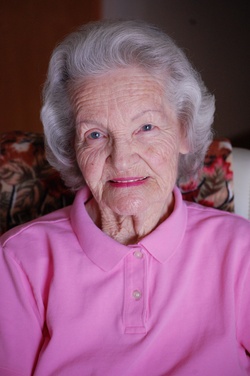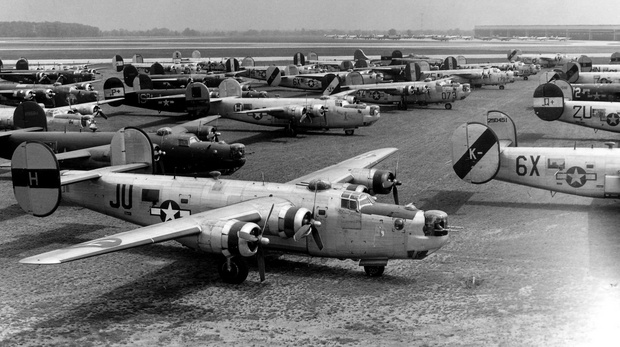Belleville woman, 86, recalls working in Willow Run bomber plant during World War II

Betty Oelke, 86, of Belleville worked at the Willow Run bomber plant during World War II.
Janet Miller | For AnnArbor.com
Betty Oelke was there at the beginning when Henry Ford built an industrial machine that rose out of a farm field east of Ypsilanti to build the workhorse of World War II, the B-24 Liberator bomber.
Now, the 86-year-old Belleville women who worked nine-hour days, six days a week, drilling holes in corrugated aluminum cockpit floors of the bomber, will watch as the factory, just a shadow of its glorious past, closes later this year, a victim of a declining auto industry.

B-24 Liberators, manufactured in Ypsilanti Township, await their shipment overseas at the Willow Run Airport during World War II.
File photo | AnnArbor.com
Oelke, who still lives just a handful of miles from the former bomber plant, helped make history, becoming one of the legions of women who swarmed into war-time factories to lend a hand as most of the male workforce went off to fight.Â
A new project at New York University's Tamiment Labor Archives is documenting the first-hand stories of real-life Rosie the Riveters, women who flooded the factory floors during World War II. Documentary Filmmakers Anne de Mare and Kirsten Kelly of Spargel Productions in New York are recording the oral histories of these women and will be in Michigan this week.
It was in the fall of 1942, just 10 months after Pearl Harbor, that Oelke, 18 years old and newly wed, decided she wanted to work at the bomber plant, which had just opened in August. “I had a time convincing my husband (Grant) to let me go,” Oelke said. Those were the days when most married women didn’t work outside the home and Oelke wanted her husband’s blessing.
But she felt a sense of duty, and liked the idea of bringing home extra income. Her husband, who also worked in the bomber plant, eventually consented. The job meant Oelke, who grew up on a farm, would buy her first pair of trousers. Â

General Motors will close the Powertrain plant at Willow Run in December.
File photo| AnnArbor.com
Her job making these giant “flying boxcars” gave Oelke a front row seat as history was being made: The bomber plant was a behemoth, the largest factory in the United States, producing 428 planes a month at its peak. A completed bomber came off the line every 55 minutes, and there were stories of pilots sleeping on cots at the plant waiting for delivery.
In the beginning, Oelke worked five days a week. But as the war intensified, she was bumped up to six days a week, with Sundays off. It was tough and repetitive work and her production output was timed. “They would stand right there and time you,” Oelke said. “We were expected to keep up. If you didn’t, you were reprimanded.” While she worked with mostly women, her bosses were all men.Â
Because of gasoline rationing, she car pooled with her husband and four others to work. When she became pregnant, who was told to take the six weeks before her due date off, but was given a $300 bonus for returning to the factory floor three weeks after the birth.
Oelke punched a clock and stood on her feet for the length of each shift, drilling a series of holes into panel of aluminum before they were sent up the line.
But Rosie the Riveter began as a fictional character, representing millions of real-life women who headed into the war factories, munitions plants and shipyards during WWII.Â
After the war, the plant was sold to Henry J. Kaiser and Joseph W. Frazer, who produced the Kaiser and Frazer car models until 1953. Oelke worked for Kaiser-Frazer for a number of years. The plant was eventually sold it to GM, who is closing it was part of it financial re-structuring.Â
While Oelke left the bomber plant before the war’s end when she and her husband returned to their family’s farm in Milan, she found herself missing her days at the factory. She’d gotten her first taste of earning her own income and work outside the home.Â
“I’d been around people all of the time, and when we moved to Milan I was alone all day,” Oelke said. “Once you work, you want to keep on doing it. I missed the people and all of the noise and I wished I was back. I felt quite proud working in the bomber plant. Most of us did.”
Janet Miller is a freelance writer for AnnArbor.com. Contact her by email at business@annarbor.com.


Comments
B24crew
Sun, Apr 25, 2010 : 10:08 p.m.
Those are definitely returned war-weary planes. There are some olive-drab painted planes in the group, and even a B-17 tail may be seen sticking up in the rear. The plane we flew in a squadron in the 15th AF was a Ford-built B24, and we considered the Ford-built planes the best of the lot. The tail markings designate the Group to which the lane belongs, and the colored engine nose cowl ring designates the squadron. This all helped in setting up the formation in the air.
hometown23
Sun, Apr 25, 2010 : 4:33 p.m.
Thanks Betty! For all your hard work and for sharing your story...what a great generation!
Top Cat
Sun, Apr 25, 2010 : 12:27 p.m.
For Warren, most of them were scrapped right after the war. With the advent of the B-29, they were viewed as unnecessary. They were not as saleable as leftover B-17s because of their reputation as difficult to fly. The Yankee Air Museum has been trying to acquire for over 25 years without success.
Warren
Sun, Apr 25, 2010 : 11:41 a.m.
The file Photo, "B-24 Liberators, manufactured in Ypsilanti Township, await their shipment overseas at the Willow Run Airport during World War II" is probably a photo of post-war-weary B24's. When my crew & I picked up a B24J in 1944, they were all unpainted aluminum. I believe that the olive drab B24's in the picture were manufactured prior to that time. B24's received their tail markings after arrival in a combat zone and assignment to a Bomb Group. I wonder how they were disposed of, since there are only two in flying condition today :(
URmaster
Sun, Apr 25, 2010 : 10:31 a.m.
Those were the glory days.